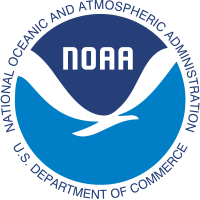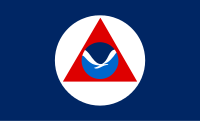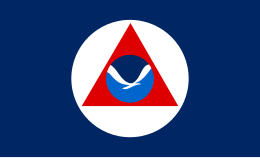
Logo of the National Oceanic and Atmospheric Administration
| |

Flag of the National Oceanic and Atmospheric Administration
| |
| Agency overview | |
|---|---|
| Formed | February 10, 1807 Reestablished: October 3, 1970 |
| Preceding agency |
|
| Jurisdiction | US Federal Government |
| Headquarters | Silver Spring, Maryland, US 38°59′32.1″N 77°01′50.3″W |
| Employees |
|
| Annual budget | US$5.6 billion (est. 2011) |
| Agency executive |
|
| Parent agency | US Department of Commerce |
| Website | NOAA.gov |
The National Oceanic and Atmospheric Administration (NOAA, /ˈnoʊ.ə/ like Noah) is an American scientific agency within the United States Department of Commerce that focuses on the conditions of the oceans, major waterways, and the atmosphere.
NOAA warns of dangerous weather,
charts seas, guides the use and protection of ocean and coastal
resources, and conducts research to provide understanding and improve
stewardship of the environment.
NOAA was officially formed in 1970 and in 2017 had over 11,000 civilian employees. Its research and operations are further supported by 321 uniformed service members who make up the NOAA Commissioned Corps.
Since October 2017, NOAA has been headed by Timothy Gallaudet, as acting Under Secretary of Commerce for Oceans and Atmosphere and NOAA interim administrator.
Purpose and function
Two NOAA WP-3D Orions
NOAA's specific roles include:
- Supplying Environmental Information Products. NOAA supplies to its customers and partners information pertaining to the state of the oceans and the atmosphere. This is clear through the production of weather warnings and forecasts via the National Weather Service, but NOAA's information products extend to climate, ecosystems and commerce as well.
- Providing Environmental Stewardship Services. NOAA is a steward of U.S. coastal and marine environments. In coordination with federal, state, local, tribal and international authorities, NOAA manages the use of these environments, regulating fisheries and marine sanctuaries as well as protecting threatened and endangered marine species.
- Conducting Applied Scientific Research. NOAA is intended to be a source of accurate and objective scientific information in the four particular areas of national and global importance identified above: ecosystems, climate, weather and water, and commerce and transportation.
The five "fundamental activities" are:
- Monitoring and observing Earth systems with instruments and data collection networks.
- Understanding and describing Earth systems through research and analysis of that data.
- Assessing and predicting the changes of these systems over time.
- Engaging, advising, and informing the public and partner organizations with important information.
- Managing resources for the betterment of society, economy and environment.
History
NOAA traces its history back to multiple agencies, some of which were among the oldest in the federal government:
- United States Coast and Geodetic Survey, formed in 1807
- Weather Bureau of the United States, formed in 1870
- Bureau of Commercial Fisheries, formed in 1871 (research fleet only)
- Coast and Geodetic Survey Corps, formed in 1917
Another direct predecessor of NOAA was the Environmental Science Services Administration (ESSA), into which several existing scientific agencies such as the United States Coast and Geodetic Survey, the Weather Bureau and the uniformed Corps were absorbed in 1965.
NOAA was established within the Department of Commerce via the Reorganization Plan No. 4 and formed on October 3, 1970 after U.S. President Richard Nixon
proposed creating a new agency to serve a national need for "better
protection of life and property from natural hazards …for a better
understanding of the total environment…[and] for exploration and
development leading to the intelligent use of our marine resources."
In 2007, NOAA celebrated 200 years of service in its role as successor to the United States Survey of the Coast. In 2013, NOAA closed 600 weather stations.
Organizational structure
NOAA Headquarters in Silver Spring, Maryland
NOAA Administrator
Since October 25, 2017 Timothy Gallaudet, Assistant Secretary of Commerce for Oceans and Atmosphere, has served as acting Under Secretary of Commerce for Oceans and Atmosphere at the US Department of Commerce and NOAA's interim administrator.
Gallaudet succeeded Benjamin Friedman, who served as NOAA's interim administrator since the end of the Obama Administration on January 20, 2017. In October 2017, Barry Lee Myers, CEO of AccuWeather, was proposed to be the agency's administrator by the Trump Administration.
NOAA Services
NOAA
works toward its mission through six major line offices, the National
Environmental Satellite, Data and Information Service (NESDIS), the National Marine Fisheries Service (NMFS), the National Ocean Service (NOS), the National Weather Service (NWS), the Office of Oceanic and Atmospheric Research (OAR) and the Office of Marine & Aviation Operations (OMAO). and in addition more than a dozen staff offices, including the Office of the Federal Coordinator for Meteorology, the NOAA Central Library, the Office of Program Planning and Integration (PPI).
National Weather Service
Seal of the National Weather Service
The National Weather Service (NWS) is tasked with providing "weather, hydrologic and climate forecasts and warnings for the United States,
its territories, adjacent waters and ocean areas, for the protection of
life and property and the enhancement of the national economy." This is
done through a collection of national and regional centers, 13 river
forecast centers (RFCs), and more than 120 local weather forecast
offices (WFOs). They are charged with issuing weather and river forecasts, advisories, watches, and warnings on a daily basis. They issue more than 734,000 weather and 850,000 river forecasts, and more than 45,000 severe weather warnings annually. NOAA data is also relevant to the issues of global warming and ozone depletion.
The NWS operates NEXRAD, a nationwide network of Doppler weather radars which can detect precipitation and their velocities. Many of their products are broadcast on NOAA Weather Radio, a network of radio transmitters that broadcasts weather forecasts, severe weather statements, watches and warnings 24 hours a day.
National Ocean Service
The National Ocean Service
(NOS) focuses on ensuring that ocean and coastal areas are safe,
healthy, and productive. NOS scientists, natural resource managers, and
specialists serve America by ensuring safe and efficient marine
transportation, promoting innovative solutions to protect coastal
communities, and conserving marine and coastal places.
The National Ocean Service is composed of eight program offices: the Center for Operational Oceanographic Products and Services, the Coastal Services Center, the National Centers for Coastal Ocean Science, the Office of Coast Survey, the Office of National Geodetic Survey, the Office of National Marine Sanctuaries, the Office of Ocean and Coastal Resource Management, and the Office of Response and Restoration.
There are two NOS programs, namely the Mussel Watch Contaminant Monitoring Program
and the NOAA Integrated Ocean Observing System (IOOS) and two staff
offices, the International Program Office and the Management and Budget
Office.
National Environmental Satellite, Data, and Information Service
NOAA engineer at work
The National Environmental Satellite, Data, and Information Service
(NESDIS) was created by NOAA to operate and manage the US environmental
satellite programs, and manage NWS data and those of other government
agencies and departments. NESDIS's National Centers for Environmental Information (NCEI) archives data collected by the NOAA, U.S. Navy, U.S. Air Force, the Federal Aviation Administration, and meteorological services around the world and comprises the Center for Weather and Climate (previously NOAA's National Climatic Data Center)
and the Center for Coasts, Oceans, and Geophysics (created by a merger
of NOAA's National Coastal Data Development Center (NCDDC), National Oceanographic Data Center (NODC) and the National Geophysical Data Center (NGDC)).
In 1960 TIROS-1, NOAA's first owned and operated geostationary satellite was launched.
Since 1966 NESDIS has managed polar orbiting satellites (POES) and since 1974 it has operated geosynchronous satellites (GOES) . In 1979 NOAA's first polar-orbiting environmental satellite was launched. Current operational satellites include NOAA-15, NOAA-18, NOAA-19, GOES 13, GOES 14, GOES 15, Jason-2 and DSCOVR. In 1983, NOAA assumed operational responsibility for Landsat satellite system.
Since May 1998, NESIDS has operated the Defense Meteorological Satellite Program (DMSP) satellites on behalf of the Air Force Weather Agency.
New generations of satellites are developed to succeed the current polar orbiting and geosynchronous satellites, the Joint Polar Satellite System) and GOES-R, which is scheduled for launch in March 2017.
NESDIS runs the Office of Projects, Planning, and Analysis (OPPA)] formerly the Office of Systems Development, the Office of Satellite Ground Systems (formerly the Office of Satellite Operations) the Office of Satellite and Project Operations, the Center for Satellite Applications and Research (STAR)], the Joint Polar Satellite System Program Office, the GOES-R Program Office, the International & Interagency Affairs Office, the Office of Space Commercialization, and the Office of System Architecture and Advanced Planning.
National Marine Fisheries Service
The National Marine Fisheries Service
(NMFS), also known as NOAA Fisheries, was initiated in 1871 with a
primary goal of the research, protection, management, and restoration of
commercial and recreational fisheries
and their habitat, and protected species. NMFS operates twelve
headquarters offices, five regional offices, six fisheries science
centers, and more than 20 laboratories throughout the United States and
U.S. territories, which are the sites of research and management of
marine resources. NMFS also operates the National Oceanic and Atmospheric Administration Fisheries Office of Law Enforcement in Silver Spring, Maryland, which is the primary site of marine resource law enforcement.
Office of Oceanic and Atmospheric Research
NOAA's research, conducted through the Office of Oceanic and
Atmospheric Research (OAR), is the driving force behind NOAA
environmental products and services that protect life and property and
promote economic growth. Research, conducted in OAR laboratories and by
extramural programs, focuses on enhancing our understanding of
environmental phenomena such as tornadoes, hurricanes, climate
variability, solar flares, changes in the ozone, air pollution transport and dispersion,
El Niño/La Niña events, fisheries productivity, ocean currents, deep
sea thermal vents, and coastal ecosystem health. NOAA research also
develops innovative technologies and observing systems.
The NOAA Research network consists of seven internal research laboratories, extramural research at 30 Sea Grant
university and research programs, six undersea research centers, a
research grants program through the Climate Program Office, and 13
cooperative institutes with academia. Through NOAA and its academic
partners, thousands of scientists, engineers, technicians, and graduate
students participate in furthering our knowledge of natural phenomena
that affect the lives of us all.
The Air Resources Laboratory
(ARL) is one of the laboratories in the Office of Oceanic and
Atmospheric Research. It studies processes and develops models relating
to climate and air quality, including the transport, dispersion, transformation and removal of pollutants
from the ambient atmosphere. The emphasis of the ARL's work is on data
interpretation, technology development and transfer. The specific goal
of ARL research is to improve and eventually to institutionalize
prediction of trends, dispersion of air pollutant plumes, air quality, atmospheric deposition, and related variables.
The Atlantic Oceanographic and Meteorological Laboratory (AOML), is part of NOAA's Office of Oceanic and Atmospheric Research, located in Miami, Florida.
AOML's research spans hurricanes, coastal ecosystems, oceans and human
health, climate studies, global carbon systems, and ocean observations.
AOML's organizational structure consists of an Office of the Director
and three scientific research divisions (Physical Oceanography, Ocean
Chemistry and Ecosystems, and Hurricane Research). The Office of the
Director oversees the Laboratory's scientific programs, as well as its
financial, administrative, computer, outreach/education, and facility
management services. Research programs are augmented by the Cooperative
Institute for Marine and Atmospheric Studies (CIMAS), a joint enterprise
with the University of Miami's Rosenstiel School of Marine and
Atmospheric Science. CIMAS enables AOML and university scientists to
collaborate on research areas of mutual interest and facilitates the
participation of students and visiting scientists. AOML is a member of a
unique community of marine research and educational institutions
located on Virginia Key in Miami, Florida.
In 1977 the Pacific Marine Environmental Laboratory (PMEL) deployed the first successful moored equatorial current meter – the beginning of the Tropical Atmosphere Ocean, TAO, array. In 1984 the Tropical Ocean-Global Atmosphere program (TOGA) program began.
Office of Marine and Aviation Operations
The
Office of Marine and Aviation Operations is responsible for the fleet
of NOAA ships, aircraft, and diving operations. It has the largest
research fleet of the Federal government. Its personnel is made up of
civilians and the NOAA Commissioned Corps. The office is headed by a NOAA Corps two-star rear admiral, who also commands the Corps.
National Geodetic Survey
The National Geodetic Survey (NGS) is the primary surveying organization in the United States.[citation needed]
National Integrated Drought Information System
The National Integrated Drought Information System
is a program within NOAA with an interagency mandate to coordinate and
integrate drought research, building upon existing federal, tribal,
state, and local partnerships in support of creating a national drought
early warning information system.
NOAA Commissioned Corps
Seal of the NOAA Commissioned Corps
The NOAA Commissioned Corps is a uniformed service of men and women who operate NOAA ships and aircraft, and serve in scientific and administrative posts.
Intergovernmental Panel on Climate Change
Since 2001, the organization has hosted the senior staff and recent chair, Susan Solomon, of the Intergovernmental Panel on Climate Change's working group on climate science.
Flag
The National Oceanic and Atmospheric Administration flag, flown as a distinguishing mark by all commissioned NOAA ships.
The NOAA flag is a modification of the flag of one of its predecessor organizations, the United States Coast and Geodetic Survey.
The Coast and Geodetic Survey's flag, authorized in 1899 and in use
until 1970, was blue, with a white circle centered in it and a red
triangle centered within the circle. It symbolized the use of triangulation in surveying, and was flown by ships of the Survey.
When NOAA was established in 1970 and the Coast and Geodetic
Survey's assets became a part of NOAA, NOAA based its own flag on that
of the Coast and Geodetic Survey. The NOAA flag is in essence the Coast
and Geodetic Survey flag, with the NOAA logo—a circle divided by the
silhouette of a seabird into an upper dark blue and a lower light blue
section, but with the "NOAA" legend omitted—centered within the red
triangle. NOAA ships in commission display the NOAA flag; those with only one mast fly it immediately beneath the ship's commissioning pennant or the personal flag of a civilian official or flag officer if one is aboard the ship, while multimasted vessels fly it at the masthead of the forwardmost mast. NOAA ships fly the same ensign as United States Navy ships but fly the NOAA flag as a distinguishing mark to differentiate themselves from Navy ships.







